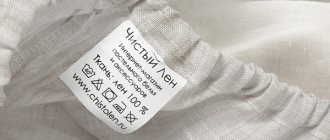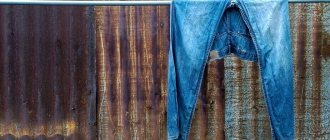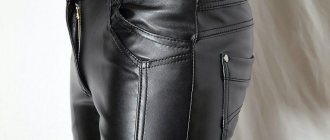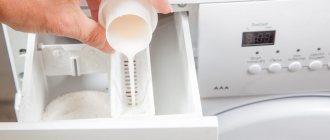Thermal underwear is a useful item in the wardrobe of adults and children who prefer sports, active games, and walks outdoors in the cold season. Such clothing retains heat, while allowing the skin to breathe and remove excess moisture to the surface. In order to use the purchased set for a long time, it is necessary to wash the thermal underwear in a timely manner and dry it properly.
How often to wash thermal underwear
One of the main questions that plagues owners of thermal underwear is “How often should I wash it?” After all, the underwear layer rarely receives visible dirt and stains. And you shouldn’t focus on the smell, since such a jacket does not accumulate unpleasant odors.
But you also can’t go without washing your clothes for a long time. In one of the previous articles, we already talked about the features of thermal underwear and therefore we know that it is distinguished by a special cellular structure of the fabric. It creates an air gap that protects against the penetration of cold air from the outside. If the material is not cleaned on time, the cells become clogged with dust, particles of the epidermis and simply cease to perform their function. This means they are no longer able to retain heat. Moisture removal also suffers, since it is also impossible to remove sweat in such conditions.
The following frequency is considered optimal:
- the kit that you wear when playing sports must be rinsed after each workout;
- It is enough to refresh clothes for daily wear and quiet walks once every 3-4 days.
Cleaning too infrequently leads to the fact that the laundry becomes very dirty and it will no longer be possible to wash it in a delicate cycle. While strong chemicals and intense friction can irreversibly damage an expensive item.
Other types of products
There is more than one type of thermal underwear, the use of which meets certain conditions:
- Warming underwear - aimed at the average level of activity in cold weather. It is used for heating and heat retention. This is a good addition to your winter wardrobe. Material: synthetic with added wool. This type of clothing includes thermal jackets and thermal overalls, the fillings of which are padding polyester, “holofiber” or down. The outer layer of thermal clothing can be natural or synthetic fabrics, for example, leatherette.
- Functional thermal underwear - removes excess moisture from the surface of the skin. It is made mainly from synthetic threads. In such things a person always feels comfortable during physical activity.
- Hybrid thermal underwear combines two qualities - it eliminates moisture and preserves heat. In addition to linen, this type of clothing includes membrane products. The purpose of the membrane is to protect from bad weather.
Features of care depending on the type of fabric
First of all, you need to figure out what material your thermal underwear is made of. Indeed, depending on the composition, the approach to care also changes:
- wool - requires very careful handling: water temperature no more than 30–35 degrees and special products for wool;
- polypropylene - hand wash in lukewarm water (30 degrees) with the addition of an antistatic agent, do not iron;
- polyester is the most undemanding of all, and therefore tolerates machine washing, gel and soap well;
- elastane - present in the fiber to give elasticity, so it is better to clean such fabric manually so as not to damage the structure.
It is prohibited to wash thermal underwear made of different types of material together: each requires a different approach. Also, do not soak the undershirt with other things, especially if they have zippers, metal buttons or snaps. This will prevent the appearance of puffs and pellets.
Note!
Let's first outline the rules that owners of thermal clothing should always remember:
- The water temperature when washing items should not exceed 40 degrees. Otherwise, this is already a destructive aggressive effect.
- Do not spin during machine washing!
- Look at the structure of the fabric: if it is brushed, both wet and dry cleaning should be done by turning the item inside out.
- Do not use bleaches or stain removers containing chlorine!
Qualities for which these clothes are valued
Which laundry detergent to choose
Not all powders and gels are suitable for thermal underwear. More precisely, no powder will do. And all because of the same cellular structure of the fabric: powder particles clog into the pores and interfere with the normal functioning of the air gap. In addition, during physical activity a person sweats, the sweat mixes with powder residues, and this mixture, in contact with the skin, can cause irritation.
More than 100 cool lessons, tests and exercises for brain development
Start developing
Here are some of the most common options for washing:
- A special gel is a product that is marked “for thermal underwear.” Just be sure to look at what fabric composition it is suitable for, since it is usually ideal for synthetics. As an example: Heitmann Spezial Waschpflege, Meine Liebe Sport, Nordland Sport, Synergetic for sportswear, etc.
- Detergent for washing woolen products - also has a liquid form and is suitable for cleaning items made from merino wool or mixed materials that contain wool.
- Laundry soap (can be replaced with soap for children's clothing) - will be needed during the manual cleansing procedure. Just keep in mind that you should not rub the material with the bar: this will clog and damage the fibers. I’ll tell you how to prepare a soap solution in the next section.
- Hair shampoo - if none of the above is on hand, then you can take a colorless transparent hair shampoo. Colored liquids with mother-of-pearl and sparkles are not suitable.
- Oxygen bleaches - they can be used only in exceptional cases to return the undergarment to its original whiteness.
- Dish detergent – it is not recommended to use it for full washing, as it is difficult to rinse out and “clogs” the fabric. But if you put a greasy stain on your suit, then delicate compounds will not cope with it, but “Fairy” or something similar will do. Apply a small amount of gel to a dry spot and leave for 10-15 minutes. Afterwards, rinse gently with water.
To prevent the item from becoming deformed and losing its properties, do not add conditioner. Chlorine-containing stain removers and bleaches are strictly prohibited.
Recommendations for spinning, drying, and ironing
You need to take care of thermal underwear carefully. Spinning for such things is contraindicated. Products washed in a machine or by hand are hung or laid out on a special grid. When excess water comes out, start drying.
Thermal underwear should not be dried near heat sources or in bright sun. This must be done in natural conditions - on the street, on the balcony, etc. If the products are drying in the room, you need to open the window and provide air flow.
To understand whether thermal underwear can be ironed, study the information indicated on the product label:
- The image of a crossed out iron indicates that its use is completely prohibited.
- A crossed out iron with one dot inside is a sign that the item can be ironed at a temperature of no more than 110 degrees. This mode is intended for synthetics.
- The two dots in the image indicate that the iron can heat up to 150 degrees (for cotton, wool). Such products are ironed through damp gauze.
How to wash clothes by hand
If you are very worried about the safety of the item, then it is better to wash it by hand. There are no special tricks in this process, but some nuances are worth knowing:
- Use either hand wash gel or soap. In the first case, it is enough to follow the manufacturer’s recommendations for dosage and soaking time, but in the second, you will have to first grind the soap using a grater or a knife. Dissolve the resulting shavings (1 tbsp) in a small volume of hot water and leave for half an hour. Then add more water to get 5 liters of liquid at a temperature of 30–40 degrees. All that remains is to lightly beat until foam forms.
- The next step is to immerse the outfit in the resulting solution, shake it slightly and squeeze it with your hands. This is necessary to ensure even distribution of water and detergent. Leave the clothes in the water for 15-30 minutes. During this time, the foam will dissolve the dirt and it will come off easily.
- Drain the dirty soap solution and, without squeezing, transfer the item into a bowl of clean water. For rinsing, it is better to take two basins: while the laundry is in one, clean water is collected in the other. It is necessary to repeat the rinsing until all the foam disappears.
Please note that the outfit must not be rubbed, twisted or vigorously squeezed. Avoid direct contact of the tap water with the fabric. Such actions can damage the delicate fibers, the suit will become deformed and irrevocably lose its properties.
Bleaching things
It is prohibited to use chlorine-containing products for thermal underwear, as they can damage the structure of the fabric. This will lead to loss of quality characteristics.
If it is necessary to restore white products that have turned gray from long-term use, then the most gentle ones are selected from the assortment offered by manufacturers. Then bleaching will not have a negative impact, preserving all the operational properties of thermal underwear aimed at preserving heat when worn.
You can use the new generation soft oxygen bleach BOS Plus. It is added to the container with detergents - 40 ml and the mode recommended for a particular type of laundry is set.
Efficiency appears already at a water temperature of 30 degrees, so deformation of the products can be avoided. It is easy to rinse without remaining in the pores of the fabric.
Oxygen bleach BOS Plus
Washing in a washing machine
Modern technology treats clothes very carefully, so thermal underwear (in most cases) can also be trusted to the washing machine. In order not to spoil the thing, it is enough to follow a few simple recommendations:
- Choose the right mode: most machines have modes like “Delicate”, “Hand Wash” - these are what we need. For wool products, the “Wool” program is recommended. The water temperature should not be higher than 30–40 degrees. It is also worth choosing at least a triple rinse and turning off the spin.
- Before loading, turn the garment inside out and place it in a special mesh bag for delicate items.
- Detergent can be added directly to the drum or tray - this point is not important.
- At the end of the cycle, open the door slightly, but do not remove the laundry for at least 15 minutes - let the excess water drain out. After all, no spinning was used in the process, which means the things are very wet.
Wool. Cotton. Polyester
The most fastidious, but also the warmest are things made of woolen material. If it is not possible to wash it manually, the spin option on the machine is turned off, and then the temperature is set to thirty-five degrees maximum.
For woolen products use liquid detergents. After washing, spinning by hand is very easy. If ironing is necessary, set the temperature to the minimum level using a damp cloth for this purpose.
- Cotton items retain heat well, which is explained by their natural hygroscopicity.
- By separating sweat for eight hours, they are able to keep your body temperature warm.
- They can withstand machine washing at a temperature of forty degrees.
- But you will need to rinse them thoroughly, for which it is recommended to additionally add an option to the cycle that includes an additional rinse.
Polyester products are most often used as training clothing, which protects and warms athletes. For machine washing, you can use the delicate cycle. In this case, spinning is completely eliminated. Ironing is usually carried out at low temperature.
In one-time cases, you can wash propylene items using a machine. All possible risks must be minimized, that is, the minimum duration of the delicate regime.
The delicate mode is selected with a short cycle duration, the temperature is set to thirty degrees, and the spin cycle must be turned off altogether. You can use a special bag that will reduce the impact of machine washing on the products.
How to properly dry and iron thermal underwear
Let's figure out how to dry clothes after washing. Since it is not advisable to twist clothes, they are sent for drying in a very damp state. At this moment, the material is very vulnerable and easily deformed. For this reason, you should not hang the garment on a rope or use clothespins. The main task is to prevent destruction of the fiber structure.
It is best to dry the set horizontally: a folding clothes dryer is ideal for this. The suit needs to be carefully laid out on top; you can put a towel under it for a while so that it absorbs excess water. It would also be a good idea to cover the surface under the dryer with absorbent rags, because some liquid will still end up on the floor.
You cannot speed up the drying process and lay the suit on a radiator or place a dryer near it. Options with a hairdryer, heating appliances, iron or steamer are also not suitable. Even direct sunlight can damage delicate material. Synthetic fabric can even melt when exposed to intense heat. Therefore, be prepared for the fact that the outfit will take a long time to dry.
It is advisable to dry such clothes outside in the shade, or on a well-ventilated balcony out of the sun.
In most cases, the undershirt does not require ironing. After all, this is a body layer that:
- not visible under the outer garment;
- It fits the figure very tightly, and the folds straighten out on their own when worn.
But if you don’t like wrinkled things, then look for a hint on whether thermal underwear can be ironed on the label. If you see a crossed out iron icon there, then don’t even dare go near the ironing board. If the iron has one point in the middle, this means that ironing on a delicate setting is allowed. If there are two points, then you can choose higher temperatures.
What is thermal underwear made of?
Warming underwear is made from natural and artificial materials. Most often used:
- merino wool is a warm material, absorbs moisture and has antibacterial properties;
- cotton is a natural soft fabric that wicks and retains moisture;
- silk is an additional material (mixed with synthetics), gives strength and softness;
- polypropylene – waterproof fabric, wicks away moisture well;
- polyamide - light and smooth synthetic material;
- elastane - elastic fibers added to fabric for wear resistance and stretch;
- polyester is the best material for sportswear, it fits nicely to the skin, wicks away moisture, and lasts a long time.
The choice of material depends on its functionality. If the main task of the set is to retain heat, it is made of wool. Athletes wear thermal underwear made of elastic synthetic material. It is light, warm, quickly removes and evaporates moisture. For everyday wear, soft underwear made of pure cotton is suitable.











